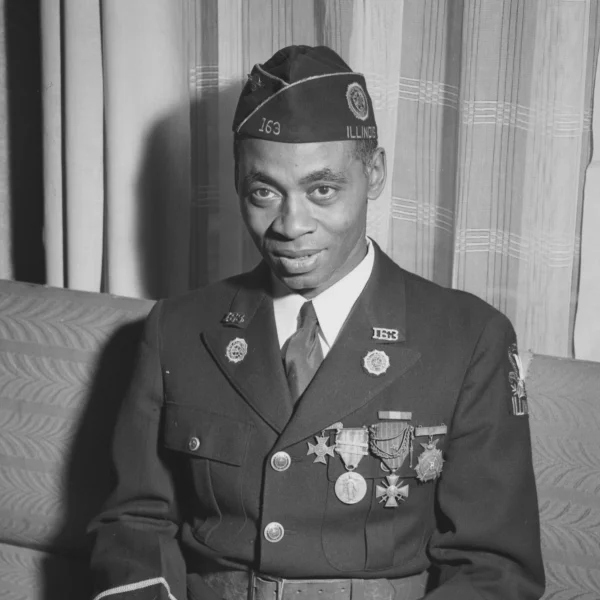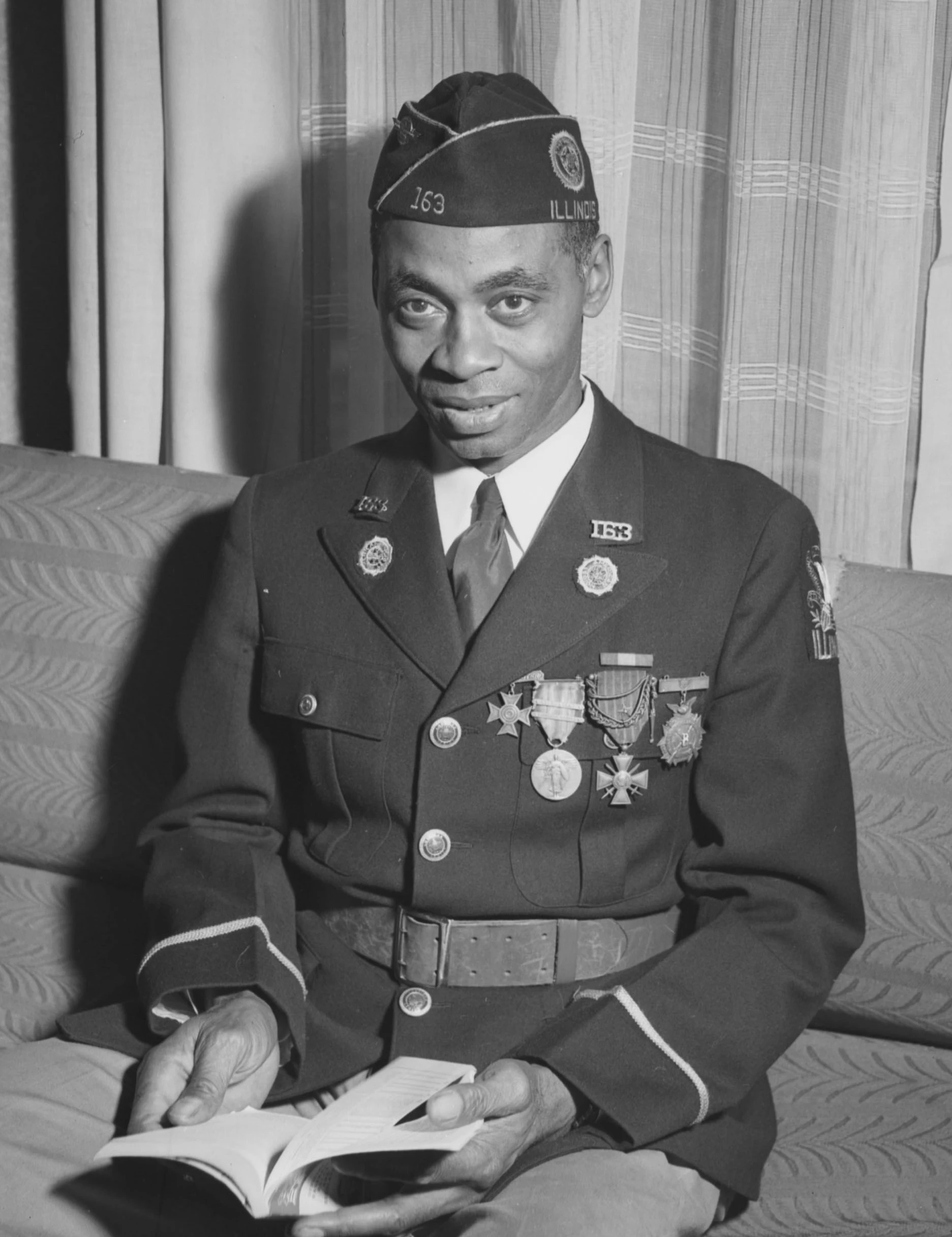During World War I, several dozen Bloomington-Normal residents fought in an African-American regiment that earned a reputation for bravery and ferocity, so much so that it’s said they were known as the “Black Devils” by the Germans.
Until 1948 and President Harry Truman’s order to desegregate the U.S. Armed Forces, African-Americans served in all-black units. At the start of WW I, for instance, dozens of “colored” residents from Bloomington-Normal and nearby communities served in Co. K of the Chicago-based Eighth Regiment, Illinois National Guard.
Co. K received orders to mobilize on July 26, 1917, and its men had but a few hours to gather at Bloomington’s Illinois Traction passenger station before they boarded interurban cars for Peoria. Wishing them farewell were a good many members of the local African-American community. Bloomington’s newest doughboys, reported The Pantagraph, “stuck their heads and hands out of the windows, and in some cases the greater part of their bodies, and shook hands with their friends, kissed their mothers or sweethearts [and] yelled their goodbyes to their friends.”
It would be a long nineteenth months before these men returned home, if at all.
After extended training in Peoria and Camp Logan, Houston, Texas, the reorganized 8th, now the 370th Infantry Regiment, arrived in France on April 22, 1918. The American Expeditionary Force and Gen. John J. Pershing didn’t want anything to do with black troops, so the 370th and three black regiments comprising the 93rd Infantry Division fought alongside the French.
The 370th fought at Lorraine and Oise-Aisne, among other battles and campaigns. In mid-August 1918, the regiment arrived at Verdun, and one month later took a position in the front lines trenches. Beginning Sept. 14 and continuing for nearly two weeks, the 370th, commanded entirely by black officers, faced hard fighting, shelling and poison gas attacks.
The Germans called them “Black Devils” for good reason—though the French, referring to their swagger and pride, called those of the 370th “Partridges” (think of puffed-up chests).
Local men from the 370th receiving special citations for bravery included Alonzo Walton of Normal, who carried supplies to his company during a German barrage, and Donald Luster and Harry L. Pierson, who ventured into “no man’s land” (the killing zone between the Allied and German lines) in an attempt to retrieve wounded comrades.
A French general praised the 370th, declaring that the spilled blood of black American soldiers mixed with that of their French brothers-in-arms, rendering “indissoluble the bonds of affection that unite us.”
Bloomington staged a grand celebration for its returning “colored soldier boys” on Feb. 27, 1919, an all-day affair that included a parade through downtown, a banquet at Wayman AME Church (then located on the 800 block of North Center Street), and a reception and dance at the old Coliseum. Speakers at the reception included Mayor E.E. Jones, Dr. Eugene Covington, a local African-American physician; Bloomington attorney and Jewish civil rights leader Sigmund Livingston; and Wayman minster Henry Simons.
The featured speaker was Adelbert Roberts, an African-American state representative from Chicago (in 1924 he became the first black state senator in Illinois). “I was glad when I got to Bloomington to see the best white people join the best black people of the city in a welcome for these ‘Black Devils,’” Roberts said. “A government that is great and grand enough to carry democracy over the seas . . . is great enough to spread it to the colored race at home. Give these boys a chance. They kept Old Glory afloat in the breeze.”
On Jun. 9, Roberts returned to Bloomington to address the first public meeting of the newly formed local chapter of the National Association for the Advancement of Colored People (NAACP).
According to The Pantagraph, he made “an eloquent appeal to the white people to give the colored race an opportunity for the higher positions in labor.” African Americans, Roberts noted, had limited employment opportunities, hindering their economic mobility and integration into wider middle class life.
Less than two months after this speech, Chicago erupted in a spasm of racial violence. The deadliest race riot in state history began on Jul. 27 when an African-American boy ventured into the white section of an informally segregated city beach, and things didn’t quiet down until Aug. 3. By the time the civil unrest was over, 38 people were dead.
In the 1910s, hundreds of thousands of African Americans left the rural South for the urban North. The Great Migration, as is would be called, increased tension and racial animosity in cities such as Chicago and Detroit.
In Bloomington, race relations steadily deteriorated in the 1920s as they did throughout much of the nation. At this time Bloomington city officials and community leaders sanctioned a de facto system of segregation that banned blacks from most downtown restaurants and hotels, and offered segregated seating in theaters.
As black and white blood ran in the streets of Chicago in late July 1919, Bloomington park officials doubled down on maintaining segregated beaches at Miller Park. Charles Thomas, a 370th veteran who ended the war a sergeant, served as custodian for the small African-American beach and its wood frame bathhouse (black and white beach facilities at Miller Park were anything but “separate but equal.”)
On Jul. 30, The Pantagraph attempted to put a positive spin on this shameful arrangement. Thomas, described as a “strapping big husky attendant,” gamely downplayed the controversy, as he likely had no interest in endangering his job by speaking out. “After going though the thickest of the fighting on the Western Front in France last year,” noted a tone deaf Pantagraph, “Thomas says that a little agitation like that raised over the Jim Crow bathing facilities at Miller Park isn’t going to bother him.”
Veterans’ organizations were also segregated at the time, so local veterans of the 370th and other African-American units organized their own American Legion post in Bloomington. The Redd-Williams Post No. 163 honored two men from the 370th killed in France, John Redd and Gus Williams.
The Simpkins Military History Museum in Heyworth has a new display commemorating the 100th anniversary of the American entry into the “Great War.” Original items on view include a “Black Devil” identification tag stamped “George Stewart, Sergt Co K 370 USNG” (the last abbreviation is short for U.S. National Guard).
Bloomington resident George Stewart, a chauffeur before the war (a common occupation for black men back then), fought with the 370th to war’s end. Upon returning to Bloomington, he worked as a city hall custodian, among other jobs. In 1953 he even ran for a seat on the city council (he lost).
Stewart passed away in 1959, and his widow, Grace Huddleston, donated his ID tag and other WW I items to Heyworth museum owner Gary Simpkins.

